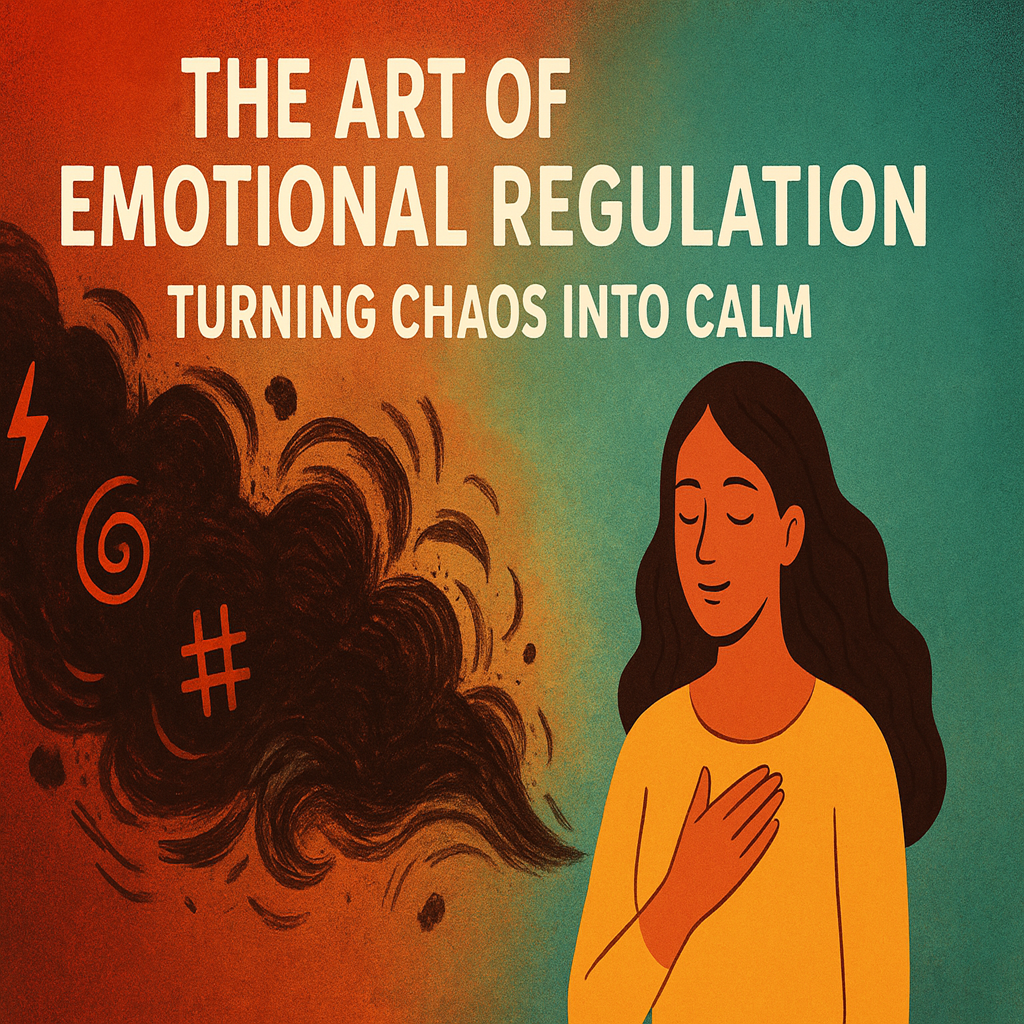
The Art of Emotional Regulation: Turning Chaos into Calm
Introduction: The Emotional Storm Within
Every human being, no matter how composed they appear, experiences emotional turbulence.
Moments of anger, anxiety, jealousy, fear, or sadness can erupt like a storm — unpredictable and overwhelming. Yet, the ability to navigate that storm — without being destroyed by it — is what we call emotional regulation.
Emotional regulation is not about suppressing feelings or pretending to be calm when you’re not. It’s about understanding, processing, and managing emotions in a healthy way. It’s the delicate art of turning internal chaos into emotional clarity — the calm after the storm.
In today’s hyperconnected, overstimulated world, mastering this art has never been more essential. Whether it’s workplace stress, relationship drama, or the constant hum of digital anxiety, emotional regulation is what keeps our mental ship steady amidst life’s rough waters.
What Is Emotional Regulation?
In psychological terms, emotional regulation refers to the ability to monitor, evaluate, and modify emotional reactions to achieve one’s goals or maintain well-being. It’s not about blocking emotions — it’s about channeling them effectively.
Imagine you’re driving. Your emotions are the engine — powerful, energetic, and necessary. But without a steering wheel, that power becomes dangerous. Emotional regulation is the steering wheel that gives direction to emotional energy.
People who regulate their emotions well are not emotionless; they are emotionally intelligent. They know how to pause before reacting, how to interpret feelings accurately, and how to express them constructively.
Learn more about Therapeutic Interventions and how can How to heal your past life trauma?
The Science Behind Emotional Regulation
Modern neuroscience reveals that emotional regulation involves a partnership between two key brain regions:
- The Amygdala — the emotional alarm system that triggers fear, anger, or excitement.
- The Prefrontal Cortex — the rational part of the brain that evaluates situations and makes balanced decisions.
When the amygdala hijacks control (as in moments of rage or panic), the prefrontal cortex goes offline — and we react impulsively.
However, with practice, we can train our brain to keep both systems in harmony. This is where emotional regulation becomes a neurobiological skill — not just a personality trait.
In fact, neuroplasticity — the brain’s ability to rewire itself — allows us to strengthen emotional control pathways through mindfulness, reflection, and cognitive exercises.
Why Emotional Regulation Matters
Unregulated emotions are like wild horses — they can throw us off balance in every area of life.
When emotions take over, our relationships suffer, decisions worsen, and mental health declines.
Let’s look at how emotional regulation impacts different areas:
In Relationships
Partners who manage emotions effectively can resolve conflicts peacefully. Instead of shouting or withdrawing, they express themselves calmly and listen actively. Emotional maturity strengthens trust and intimacy.
For Mental Health
Poor emotional regulation is linked with anxiety, depression, and burnout. Learning to manage emotions creates emotional resilience — a buffer that prevents stress from turning into suffering.
For Self-Growth
The ability to observe your feelings without being ruled by them is the foundation of self-awareness, inner peace, and spiritual maturity.
Common Emotional Dysregulation Patterns
Understanding where chaos begins is key to finding calm.
Here are some common patterns of emotional dysregulation many people unconsciously repeat:
1. Suppression
Pretending you’re fine when you’re not. This pushes emotions deeper into the subconscious, leading to physical or mental exhaustion later.
2. Projection
Blaming others for your emotional discomfort. Instead of processing anger or sadness, it’s externalized.
3. Rumination
Replaying painful moments repeatedly, amplifying emotional distress.
4. Avoidance
Distracting yourself with social media, food, or work to escape uncomfortable emotions.
5. Emotional Over-identification
Becoming your emotions (“I am angry” instead of “I feel angry”), which makes them more powerful.
Recognizing these patterns is the first step to transforming them.
The Psychology of Emotional Regulation
Psychologists have developed several models to understand how emotions can be regulated.
One of the most well-known is James Gross’s Process Model of Emotion Regulation, which includes five stages:
1. Situation Selection
Choosing environments or experiences that influence emotions. (Example: avoiding negative social circles.)
2. Situation Modification
Changing aspects of the environment to manage emotions. (Example: leaving a heated argument before saying something regrettable.)
3. Attention Deployment
Directing focus intentionally. (Example: mindfulness meditation or journaling.)
4. Cognitive Change
Reframing how we think about a situation. (“This challenge is teaching me resilience.”)
5. Response Modulation
Managing physical and emotional reactions. (Example: deep breathing or relaxation.)
This model reminds us that emotional regulation begins long before an emotional explosion happens — it’s a preventive art, not just a reactive one.
How to Practice Emotional Regulation: Step-by-Step
Here’s a simple yet powerful roadmap to mastering your emotional balance:
1. Pause Before Reacting
When triggered, the first few seconds are crucial.
Instead of reacting instantly, pause — take a deep breath. This gives your prefrontal cortex time to regain control over the amygdala.
Tip: Inhale for 4 seconds, hold for 4, exhale for 4, hold for 4 — the “box breathing” technique used by Navy SEALs to stay calm under stress.
2. Name the Emotion
Label what you feel: anger, disappointment, jealousy, fear.
Neuroscience shows that naming emotions reduces their intensity — a process called “affect labeling.”
It creates a mental gap between you and your feelings.
3. Ask Yourself Why
Go deeper: Why am I feeling this?
Sometimes anger hides sadness. Jealousy hides insecurity. Fear hides a need for safety. When you uncover the true emotion beneath the surface, healing begins.
4. Reframe the Thought
Change your inner dialogue. Instead of “I can’t handle this,” say, “This is difficult, but I can manage it.”
Cognitive reframing changes emotional responses by altering perspective.
5. Engage in Grounding Techniques
When emotions surge, reconnect with the present:
- Notice five things you see
- Four things you can touch
- Three things you hear
- Two things you smell
- One thing you taste
Grounding pulls you back to now, stopping emotional spirals.
6. Practice Mindful Observation
Observe emotions like waves — they rise and fall. Don’t chase or suppress them. Breathe, watch, and let them pass.
You’ll realize no emotion lasts forever.
7. Express, Don’t Explode
Write, talk, paint, dance — express your feelings creatively.
Expression releases emotional energy safely without harming yourself or others.
8. Cultivate Self-Compassion
Treat yourself as you would treat a hurting friend.
Say: “It’s okay to feel this. I’m doing my best.”
Self-compassion quiets the inner critic that fuels emotional turmoil.
The Role of the Body in Emotional Regulation
Emotions are not just mental — they’re physiological experiences stored in the body. That’s why emotions can be felt in the chest, stomach, or throat. When emotions are suppressed, the body carries the tension.
To regulate emotions, you must work through the body too:
- Breathing exercises calm the nervous system.
- Yoga and stretching release stored emotional energy.
- Progressive muscle relaxation helps identify where tension hides.
- Dancing or movement therapy helps process repressed emotions.
The body becomes the bridge between emotional chaos and inner calm.
The Role of Sleep, Nutrition, and Environment
Emotional regulation isn’t purely psychological — it’s also biological. Sleep deprivation, poor diet, and overstimulation from screens can all destabilize emotions.
- Sleep: Lack of rest amplifies amygdala reactivity by up to 60%.
- Nutrition: Blood sugar drops and dehydration can trigger irritability and anxiety.
- Digital Overload: Constant notifications keep the brain in a reactive mode.
Thus, maintaining physical balance supports emotional balance. The calmer the body, the calmer the mind.
Emotional Regulation and Relationships
Healthy relationships thrive on emotional maturity. When both partners can express feelings respectfully and manage triggers, the bond strengthens.
Try this 3-step communication model Sin emotionally charged moments:
- 1- State your feeling: “I feel hurt.”.
- 2- Explain the reason: “Because I felt ignored during our talk.”
- 3- Suggest a solution: “Can we discuss this later when we’re both calm?”
This turns conflict into connection. Instead of attacking, you invite understanding — the essence of emotional intelligence.
Tools to Build Emotional Regulation
Here are practical tools to help you strengthen your emotional muscles daily:
- Mindfulness meditation (10–15 minutes daily)
- Journaling emotional experiences
- Therapy or coaching for emotional awareness
- Breathing exercises for stress control
- Gratitude practice to shift focus from lack to abundance
- Digital detox to reduce emotional overwhelm
With consistency, these habits rewire your emotional responses — transforming chaos into clarity.
The Spiritual Dimension of Emotional Regulation
Many ancient traditions — from Buddhism to Stoicism — have taught emotional regulation as a spiritual discipline.
The rise of social media also highlights shadow dynamics. Online trolling, cancel culture, and envy are modern expressions of collective shadow projections. By acknowledging these, society can work toward more conscious digital behavior.
In Stoic philosophy, it’s called apatheia — not indifference, but inner serenity regardless of external chaos.
In Buddhism, imindfulness and non-attachment help observe emotions without being consumed by them.
Even modern psychology, echoes this wisdom: peace comes from acceptance, not avoidance.
True emotional regulation is not suppression; it’s alignment — between what you feel and how you choose to act.
Conclusion: The Calm Within the Storm
The art of emotional regulation is not learned overnight. It’s a lifelong practice — a dance between awareness and acceptance.
“One does not become enlightened by imagining figures of light, but by making the darkness conscious.”
You will still feel anger, fear, sadness, or jealousy — but you’ll no longer drown in them. Instead, you’ll surf the waves with grace and strength.
Turning chaos into calm is not about changing what you feel, but about changing how you relate to what you feel.
When you master that, emotions stop being enemies and become your greatest teachers — guiding you toward wisdom, empathy, and peace.

